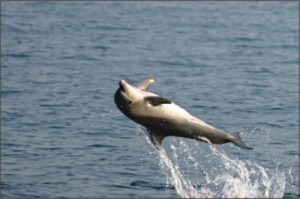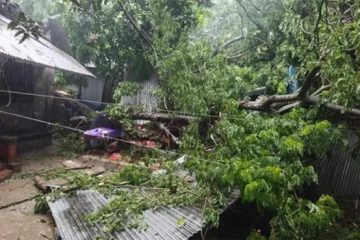 A school of gangetic dolphins have returned to the rivers Turag and Buriganga with the flow of fresh floodwater from the upstream.
A school of gangetic dolphins have returned to the rivers Turag and Buriganga with the flow of fresh floodwater from the upstream.
Several dolphins were sighted recently near Shoalmachi in the river Turag and at Jhaochar, a kilometre downstream in the river Buriganga, much to the delight of environmentalists and local boatmen.
But the delight is short-lived as the fresh water flow in all the rivers around the capital city will soon start to recede and dumping of millions of tonnes of toxic waste into the river water will make it impossible for any aquatic life to survive.
If the escape route towards the freshwater of the rivers Dhaleshwari and Meghna is cut off, these aquatic mammals, representing a healthy atmosphere, will face certain death.
Boatmen in the Turag and Buriganga said every year with the flow of floodwater some dolphins return to the area. But as soon as the floodwater recedes and the river loses its current and flow, these dolphins become trapped in extremely polluted water and die.
Two years ago this correspondent witnessed a mature gangetic dolphin die in the extremely polluted water of the Buriganga near Looterchar.
“At present the river pollution is not visible as flood water instantly carries away all toxic waste dumped into the river,” said Abdul Baten, a Buriganga boatman from Waaspur.
“Within a month when the river water gets stagnant and turns pitch black these shushuks and fishes will surely die,” Baten added.
Other boatmen said this year some of the dolphins they spotted near Amin Bazar Bridge bore marks of white patches on their back.
Khasru Chowdhury, a wildlife expert, said the dolphins with marks of white patches are probably suffering from fungal infection due to exposure to pollution.
“However, return of the dolphins is a very positive sign for the river system around the capital but we have to contain pollution to preserve this rare aquatic mammals,” Khasru said.
“Biodegradable waste cannot do much harm to the aquatic lives but toxic waste can wipe them out very quickly,” he added.
Gangetic dolphins are almost blind and they navigate and hunt for fish and shellfish by using a very powerful sonar system. So they easily hunt and move in the silted and murky water of our rivers.
“As long as there is flow in the river these dolphins will survive but in the stagnant river water these mammals may get trapped in pockets and face the inevitable — death,” Khasru added.
International Union for the Conservation of Nature (IUCN) classifies the gangetic dolphin as endangered species. Gangetic dolphins can be found in the gangetic basin and its tributaries in Bangladesh, India and Nepal.
Other sub-species of the gangetic dolphins can be found in sweet water of other countries in the region.




















